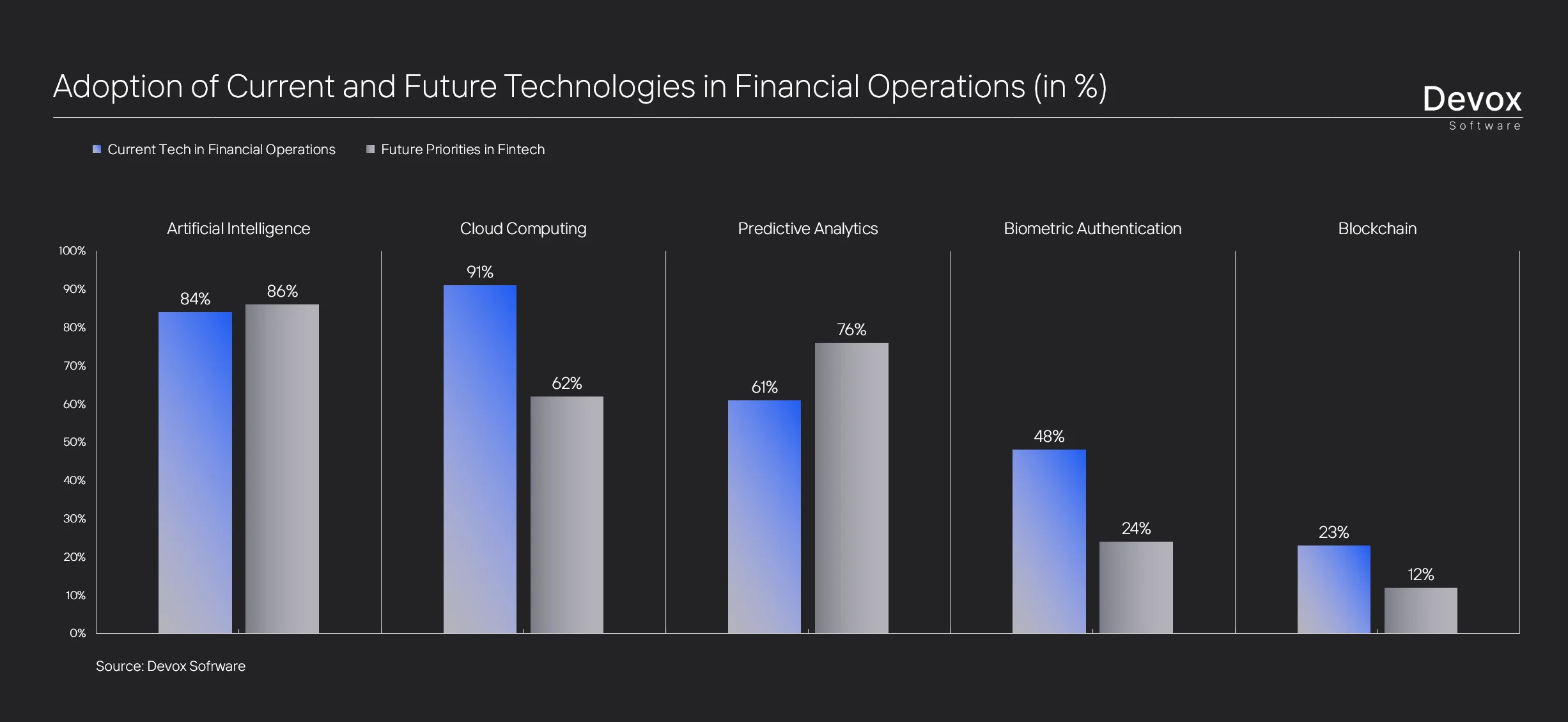Table of content
The fintech future is evolving at breakneck speed, and companies that embrace forward-looking technologies are leading the charge.
In an industry defined by constant change, one principle remains steadfast: the customer is king. A laser focus on personalization, security, and user experience has become the gold standard for innovation.
To understand how modern fintech companies prioritize technological advancements, we surveyed to capture their focus areas. Our survey clearly shows that technology is not the differentiator; implementation is. Successful companies treat customer knowledge as a strategy, not a feeling. Every click, every interaction — absorbed, learned, used.
This is more than a trend report. It’s a look under the hood of the most adaptable, data-driven, and ambitious minds in finance — the ones setting the pace for future trends in fintech.
AI in Fintech: The Powerhouse of Precision and Personalization
In 2025, artificial intelligence has woven itself into the fabric of financial technology, becoming a defining force for every future fintech company. Not as a novelty or an experiment but as a critical infrastructure that drives everything from risk modeling to customer experience.
Our findings show that 84% of fintech companies are already integrating AI into their core business, and adoption is accelerating. This isn’t disruption—it’s redefinition.
Nowhere is the impact of AI more evident than in decision-making. As cyber threats become more sophisticated, AI is responding with predictive power. It identifies risks before they manifest, and closes vulnerabilities in real time.
Then comes personalization. AI decodes behavior at a granular level, refining every customer interaction.
Finally, AI-driven automation has eliminated inefficiencies. Credit scoring, regulatory compliance, and onboarding — once bottlenecks — now serve as stepping stones. This allows teams to focus on market strategy instead of bogged down in lengthy processes.
But no real progress comes without friction. The legal framework has not kept pace with the speed of AI deployment. Companies are operating in a gray area and making critical decisions without precedent. The looming burden of technical debt is also moving faster than systems can cope.
But experienced companies today do not see this as an obstacle, but as a field for experimentation. Our data shows that 61% of leading fintech companies are increasing their use of predictive analytics. They see the risk and are doubling down on it.
These challenges may be complex, but they’re also shaping the future of AI in fintech.
Predictive Analytics: Turning Data into Foresight
In the financial sector, data without direction is just noise. Predictive analytics brings clarity and insights that influence product development, customer loyalty, and risk management.
This capability not only leads to smarter decisions but also builds trust. 61% of the industry leaders we surveyed ranked predictive analytics as a top strategic priority, highlighting its importance for fraud prevention and customer acquisition.
Whether detecting cybersecurity threats or refining credit scores, this technology is an early warning system, enabling organizations to act before problems escalate. In a world of constant disruption, companies use predictive analytics to amaintain their edge in highly competitive markets.
By the way, predictive analytics also comes with challenges despite its promising possibilities. Fintech companies face difficult decisions — developing predictive tools in-house or partnering with third-party solutions. Either path has implications for scalability, agility, and cost.
The challenge is to obtain high-quality data. On the other hand, those who realize their full potential can redefine the customer relationship, and chart a course for an industry that thrives on foresight.
It’s clear: the future of fintech belongs to those who treat data not as a resource but as a strategy. Predictive analytics is the compass — and those who master it best will set the direction that everyone else will follow.
Cloud Computing: Powering Fintech with Limitless Scale
By leveraging cloud platforms, companies scale their operations and reduce costs. With its unrivaled flexibility, the cloud frees companies from the burden of legacy infrastructure.
The elasticity of the cloud ensures operations can expand — or contract — at the speed of demand. No longer need to add cumbersome servers or risk service outages at critical moments. For fintech companies, growth potential isn’t limited, and resources aren’t wasted in quieter periods.
The cloud is also a fortress. Providers like AWS and Google Cloud offer robust, financial technology-specific security measures, like encryption, multi-factor authentication, and real-time threat monitoring. With these tools, companies can safely navigate the complex maze of regulations such as GDPR, PSD2, and beyond.
Of course, the road to cloud adoption isn’t without its hurdles. Issues such as data sovereignty, compliance with regulations in different jurisdictions, and the specter of vendor lock-in shouldn’t be underestimated. However, multi-cloud strategies are emerging as an antidote, giving fintech companies the freedom to combine the best capabilities of different providers while minimizing risk. In addition, the cloud doesn’t just optimize costs and encourages creativity, and allows companies to push boundaries without breaking the budget.
For fintech companies willing to embrace this dynamic tool, the sky isn’t the limit — it’s the starting point.
Embedded Finance: Banking Beyond Banks
Embedded finance — the integration of financial services into non-financial platforms — is changing the fintech landscape. With 74% of consumers worldwide using embedded financial solutions in 2024 and the market expected to reach $7.2 trillion by 2030 (Bain & Company), this innovation is revolutionizing both consumer interactions and business strategies.
The benefits of embedded finance are transformative for both sides of the equation. For businesses, embedded financial solutions unlock new revenue streams, drive customer loyalty, and increase engagement by meeting users’ needs directly on the platform. For consumers, it simplifies transactions, reduces friction, and provides financial services in context. For example, Buy Now, Pay Later (BNPL) options have redefined the shopping experience and allow consumers to integrate payment solutions into their shopping journey seamlessly.
Embedded financial services enable non-financial businesses to directly integrate services such as payments, loans, insurance, and banking into their ecosystem, creating a frictionless user experience. E-commerce platforms like Shopify allow merchants to manage credit, fees, and deposits without leaving the platform, while ride-hailing apps like Uber streamline transactions with in-app wallets for drivers and riders alike. These integrations transform platforms into end-to-end service hubs that improve functionality and user experience.
Let’s get started. The future of fintech is already in motion.
Cybersecurity: the Backbone of Digital Finance
Global cybercrime damages will reach $10.5 trillion annually by 2025 (Source: Cybersecurity Ventures).
As one of our respondents stated, Chief Commercial Officer:
“Balancing Gen AI creative skill with the cost of those resources- offshoring does not provide the skills base needed for what we need. Delivering on a specific product roadmap for Gen AI – challenges in consolidating needs of anchor customer versus other more generic deals.”
In a financial landscape characterized by digital innovation, cybersecurity has evolved from a supporting role to a business-critical necessity. With global cybercrime losses set to reach $10.5 trillion annually in 2025 (Cybersecurity Ventures), the need for fintech companies to protect sensitive data, maintain consumer trust and ensure uninterrupted operations is more evident than ever.
The rapid rise of cloud computing, AI, and embedded finance has changed the industry, but it has also made it more vulnerable. Each innovation has increased the complexity of cyber security to a new level.
Biometric authentication and behavioral analysis have become indispensable parts of modern fintech security solutions. Fingerprints, keystroke dynamics, and user behavior patterns enable precise, passive identification, providing robust protection without disrupting the user experience. These technologies reconcile the need for compliance with the expectation of intuitive access.
The industry is under increasing pressure. Innovation leads to complexity, and complexity brings risk. Cyber threats have become more sophisticated, more frequent, and more expensive. Countering this requires more than just technical upgrades — it requires structural change.
Zero-trust architectures are being introduced to ensure continuous and unconditional scanning. Every action is treated as a potential risk and intentionally authorized. Blockchain-based security models establish verifiable, tamper-proof systems that strengthen transaction integrity and operational transparency.
These advances reflect a clear shift in mindset. Security is no longer treated as a hurdle to overcome or a line item to manage but is embedded directly into product design, user experience, and strategic planning. Companies that invest in resilient infrastructures reduce their risk, build trust, increase their agility, and define their value in a rapidly evolving ecosystem.
Cybercrime today operates on a global scale and reaches the financial weight of economies. In this environment, security planning must rise to the same level as product development and growth strategy. For fintech, long-term viability depends on this alignment—not just to withstand threats but to lead with confidence.
Biometric Security: Effortless Access, Ironclad Protection
Security and convenience are no longer mutually exclusive. Fintech companies are embracing biometric authentication to ensure customers can access their accounts and perform transactions securely without sacrificing ease of use. This emphasis on biometric security reassures customers.
By enabling fast and secure access, biometrics ensure that customers can interact with financial services effortlessly — without compromising security. From fingerprints to facial recognition, these technologies are closing the security gaps left by traditional passwords and transforming the user experience. For instance, voice-based authentication quickly becomes a favorite for mobile platforms and call centers. Analyzing speech patterns provides effortless results.
Moreover, behavioral biometrics is redefining real-time threat detection. By analyzing subtle user behavior — typing speed, mouse movements, or even the way someone holds a device — it acts as a silent sentinel, detecting suspicious activity before it escalates.
In 2025, biometric security will combine best-in-class security with effortless ease of use, which is great news for businesses and consumers.
Blockchain: Trust, Transparency, Transformation
Blockchain technology is changing financial technology. It offers unrivaled transparency, security, and efficiency in financial transactions. The global blockchain market is expected to grow 143-fold by 2030 and could be worth 1.5 trillion dollars. This will reshape the foundations of financial services.
At its core, blockchain is a decentralized and immutable ledger that ensures every transaction is securely recorded and verifiable. Leading financial companies like Visa, Mastercard, and PayPal already use blockchain. This technology ideally enables faster and more secure cross-border payments.
Meanwhile, the applications of blockchain go far beyond pure payment processing. The technology supports smart contracts that automate agreements between parties without the need for third-party monitoring. In lending, for example, smart contracts can automatically make repayments based on predefined terms, increasing efficiency and trust. Blockchain solutions are also essential for regulatory compliance — they improve transparency and traceability for audits, KYC, and AML. This level of automation and transparency has become a focal point in future fintech news, especially among investors and regulators.
Decentralized finance (DeFi) is another important application of blockchain in fintech. Aave and Compound using blockchain to build permissionless financial systems. Users can borrow, lend, or trade money without intermediaries.
Blockchain is no longer a futuristic concept. It sets new standards for transparency and security in finance. It promotes trust, enables efficiency, and supports innovations such as DeFi and CBDCs. Fintech companies that embrace blockchain technology today are not only adapting to change but also actively shaping the future of global finance.
Open Banking: Empowering Finance Through Data
Open banking is also rewriting the rules of finance. By enabling secure, seamless data exchange between banks and third-party providers, it empowers consumers to take control of their data. For an industry that is often criticized for being rigid and opaque, open banking is a much-needed game-changer.
At its core, open banking uses APIs to unleash new possibilities — think more innovative budgeting tools, real-time expense tracking, and lightning-fast credit approvals. The global open banking market is set to grow at a staggering compound annual growth rate of 27.2%, reaching $135.17 billion by 2030.
Open banking also reaches places where traditional finance fails. Open frameworks offer viable alternatives in underserved regions where traditional institutions lack flexibility or interest. Individuals gain access to flexible credit, adaptable savings, and financial services tailored to the volatility of the real world rather than the convenience of institutions.
This movement does more than just streamline. It challenges incumbents to rethink their value. It rewards products that focus on utility rather than making a quick buck. And it marks a shift from owning data to managing experiences.
More and more, at “The Future of Fintech” conferences, you’ll hear one message loud and clear. This decade belongs to the companies that harness open banking to build inclusive, transparent, and customer-first solutions.
Sum Up
This is where the next decade begins.
We spoke to the minds building the future of finance — not theorists, but doers. Our research reveals a consistent thread: decisive implementation of transformative technologies grounded in customer insight and enabled by resilient infrastructure. Success doesn’t hinge on having access to the latest tech. It hinges on knowing what to do with it.
AI, predictive analytics, cloud computing, and embedded finance aren’t trends but strategic tools. Used well, they accelerate decision-making, de-risk innovation and scale impact.
AI sharpens decisions, the cloud unlocks velocity, predictive analytics turns noise into signals, and embedded finance redraws customer journeys. But none of it matters without clarity of purpose and the right team to bring it to life.
At Devox Software, we work with fintech companies who don’t just want to react to change — they want to shape it. We help them build with precision, move confidently, and solve the hard problems others avoid.
If you’re serious about scaling a fintech product that earns trust, adapts in real time, and leaves your competitors guessing — we’re ready to get to work.
Fintech moves fast. Build with those who can keep up.













